NCERT Solutions For Class 11 Biology Transport in Plants
Topics and Subtopics in NCERT Solutions for Class 11 Biology Chapter 11 Transport in Plants:
| Section Name | Topic Name |
| 11 | Transport in Plants |
| 11.1 | Means of Transport |
| 11.2 | Plant-Water Relations |
| 11.3 | Long Distance Transport of Water |
| 11.4 | Transpiration |
| 11.5 | Uptake and Transport of Mineral Nutrients |
| 11.6 | Phloem Transport: Flow from Source to Sink |
| 11.7 | Summary |
NCRT TEXTBOOK QUESTIONS SOLVED
1.What are the factors affecting the rate of diffusion?
Solution. Factors affecting the rate of diffusion are :
- Density – Rate of diffusion of a substance is inversely proportional to square root of its relative density (Graham’s Law).
- Permeability of medium – Rate of diffusion decreases with density of the medium.
- Temperature – A rise in temperature increases the rate of diffusion with Q10 = 1.2 -1.3. Because of it sugar crystals do not dissolve easily in ice cold water while they do so easily in warm water.
- Diffusion pressure gradient – Rate of diffusion is directly proportional to the difference of diffusion pressure at the two ends of a system and inversely proportional to the distance between the two.
2.What are porins? What role do they play in diffusion?
Solution: The porins are proteins that form huge pores in the outer membranes of the plastids, mitochondria and some bacteria allowing molecules up to the size of small proteins to pass through. Thus they play an important ‘ role in facilitated diffusion.
More Resources for CBSE Class 11
- NCERT Solutions
- NCERT Solutions Class 11 Maths
- NCERT Solutions Class 11 Physics
- NCERT Solutions Class 11 Chemistry
- NCERT Solutions Class 11 Biology
- NCERT Solutions Class 11 Hindi
- NCERT Solutions Class 11 English
- NCERT Solutions Class 11 Business Studies
- NCERT Solutions Class 11 Accountancy
- NCERT Solutions Class 11 Psychology
- NCERT Solutions Class 11 Entrepreneurship
- NCERT Solutions Class 11 Indian Economic Development
- NCERT Solutions Class 11 Computer Science
3.Describe the role played by protein pumps during active transport in plants.
Solution: Active transport uses energy to pump molecules against a concentration gradient. Active transport is carried out by membrane play a major role in both active as well as passive transport. Pumps are proteins that use energy to carry substances across the cell membrane. These pumps can transport substances from a low concentration to a high concentration (‘uphill’ transport). E.g.,H+ pump,K+ pump, Cl- pump, Na+-K pump.The pumps operate with the help of ATP.K+-H+ exchange pump occurs in guard cells. Na+-K+ exchange pump operates across many animal membranes. Transport rate reaches a maximum when all the protein transporters or pumps are being used or are saturated.Like enzymes these carrier proteins are very specific in what they carry across the membrane. These proteins are sensitive to inhibitors that react with protein side chains.
4. Explain why pure water has the maximum water potential.
Solution: Water molecules possess kinetic energy. In liquid and gaseous form they are in random motion that is both rapid and constant. The greater the concentration of water in a system, the greater is its kinetic energy or ‘water potential’. Hence, it is obvious that pure water will have the greatest water potential. Water potential is denoted by the Greek symbol Psi or ψ and is expressed in pressure units such as pascals (Pa). By convention, the water potential of pure water at standard temperatures, which is not under any pressure, is taken to be zero. If some solute is dissolved in pure water, the solution has less free water and the concentration of water’decreases, reducing its water potential. Hence, all solutions have a lower water potential than pure water.
5.Briefly describe water potential. What are the factors affecting it?
Soln. The term water potential was first used by Slatyer and Taylor (1960). The free energy per mole of any particular chemical species in a multicomponent system is defined as the chemical potential of that species. The chemical potential of water is referred to as the water potential (ψw). Since the ψ of pure water is zero (0), the presence of solute particles reduces the free energy of water, thus decreases the water potential (negative value). Therefore,ψ of solution is always less than zero or its highest value is zero.
For solutions water potential is determined by three internal factors, i.e.,ψw = ψm + ψs + ψp (where ψm is matric potential which is used for the surface such as soil particles or cell wall to which water molecules are absorbed, ψsis solute potential, also called osmotic potential, the amount by which water potential is reduced and ψp is pressure potential such as TP and WP). Since in plant system ψm is disregarded the equation may be simplified as :
ψw = ψs + ψp
6. What happens when a pressure greater than the atmospheric pressure is applied to pure water or a solution?
Solution: If a pressure greater than atmospheric pressure is applied to pure water or a solution, its water potential increases. It is equivalent to pumping water from one place to another. Pressure can build up in a plant system when water enters a plant cell due to diffusion causing a pressure built up against the cell wall, it makes the cell turgid.
7. (a) With fhe help of well-labelled diagrams, describe the process of plasmolysis in plants, giving appropriate examples.
(b) Explain what will happen to a plant cell if it is kept in a solution having higher water potential.
Soln.(a) Shrinkage of the protoplast of a cell from its cell wall under the influence of a hypertonic solution is called plasmolysis. Hypertonic solution causes exosmosis or withdrawal of water from cytoplasm and then the central vacuole of cell. The size of cytoplasm, as well as central vacuole and hence protoplast, becomes reduced. The first stage of plasmolysis is called limiting plasmolysis. At limiting plasmolysis, the pressure potential ( ψp ) is zero and the osmotic concentration of cejl interior is just equivalent to that of external solution (isotonic). The cell is called flaccid. When pressure potential becomes negative, the protoplast withdraws itself from the comers. This stage is known as incipient plasmolysis. At incipient plasmolysis, the cell wall exerts no pressure on the cell contents (i.e. ψp is zero). Hence at this stage ψw = ψs. The hypertonic solution now enters the cell in between the protoplast and the cell wall. Due to continued exosmosis, protoplast shrinks further and withdraws from the cell wall except one or a few points. It is known as evident plasmolysis.
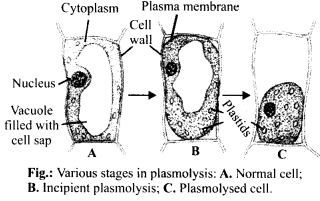
Examples of plasmolysis :
(i) Pickles, meat and fish are preserved by salting. Similarly, jams and jellies are preserved by sweetening with sugars. Salting and sweetening create hypertonic condition in which the fungi and bacteria get killed by plasmolysis.
(ii)Salting kills the weeds of lawns by inducing plasmolysis in their cells.
(iii)Plasmolytic method is applied for the determination of osmotic pressure of a cell in the laboratory.
(b) When the cells are placed in a solution having higher water potential i.e., hypotonic solution (dilute solution as compared to the cytoplasm), water diffuses into the cell causing the cytoplasm to build up a pressure against the wall, that is called turgor pressure. The pressure exerted by the protoplasts due to entry of water against the rigid walls is called pressure potential ψp . Because of the rigidity of the cell wall, the cell does not rupture. This turgor pressure is ultimately responsible for – enlargement and extension of cells.
8.How is the mycorrhizal association helpful in absorption of water and minerals in plants?
Soln. Some plants have additional structures associated with them that help in water (and mineral) absorption. A mycorrhiza is a symbiotic association of a,fungus with a root system. The fungal filaments form a network around the young root or they penetrate the root cells. The hyphae have a very large surface area that absorb mineral ions and water from the soil from a much larger volume of soil that perhaps a root cannot do. The fungus provides minerals and water to the roots, in turn the roots provide sugars and N-containing compounds to the mycorrhizae. Some plants have an obligate association with the mycorrhizae. For example Pinus seeds cannot germinate and establish without the presence of mycorrhizae.
9.What role does root pressure play in water movement in plants?
Soln. As various ions from the soil are actively transported into the vascular tissues of the roots, water follows (its potential gradient) and increases the pressure inside the xylem. This positive pressure is called root pressure, and can be responsible for pushing up water to small heights in the stem. Root pressure can, at. best, only provide a modest push in the overall process of water transport. They obviously do not play a major role in water movement up tall trees. The greatest contribution of root pressure may be to re-establish the continuous chains of water molecules in the xylem which often break under the enormous tensions created by transpiration.
10.Describe transpiration pull model of water transport in plants. What are the factors influencing transpiration? How is it useful to plants?
Soln.Transpiration pull or cohesion-tension theory was originally proposed by Dixon and Joly in 1894 and further improved by Dixon in 1914. According to this theory, a continuous
column of water is present in the xylem channels of plant. The continuity of water column is maintained in the plant because of cohesive force of water molecules. There is another force of adhesion which holds water tp the walls of xylem vessels. During transpiration in plants, water is lost, in form of water vapour, from the mesophyll cells to exterior, through stomata. As a result, the turgor pressure of these cells decreases and the diffusion pressure deficit (DPD) increases. Now these cells take water from adjoining cells and the turgor of those adjoining cells decreases. This process is repeated and ultimately water is absorbed from nearest xylem vessels of leaf. As there is a continuous water column inside the xylem elements, a tension or pull is transmitted down and finally transmitted to root, resulting in the upward movement of water.
Factors affecting transpiration include both environmental and internal factors. Environmental factors:
(i) Relative humidity – The rate of transpiration is inversely proportional to the relative humidity, i.e., the rate of transpiration is higher when the relative humidity is lower and lower when the relative humidity is higher.
(ii)Atmospheric temperature – A high temperature opens stomata even in darkness. Besides producing a heating effect, it lowers the relative humidity of the air and increases vapour pressure inside transpiring organ. Consequently, rate of transpiration increases.
(iii)Light – Because most of the transpiration occurs through stomata, the rate of transpiration is quite high is light. It falls down appreciably in the darkness.
(iv)Air movements – Transpiration is lower in the still air because water vapours accumulate around the transpiring organs and reduce the DPD of the air. The movement of the air increases the rate of transpiration by removing the saturated air around the leaves.
(v) Atmospheric pressure – Low atmospheric pressure enhances evaporation, produces air currents and increases the rate of transpiration.
(vi)Availability of water – The rate of transpiration depends upon the rate of absorption of soil water by roots. This is further influenced by a number of soil factors like soil water, soil particles, soil temperature, soil air, etc.
Internal or plant factors :
(i) Leaf area (transpiring area) – A plant with large leaf area will show more transpiration than another plant with less leaf area.
(ii)Leaf structure – Leaf structure affects transpiration in following ways:
(a) Cuticular transpiration decreases with the thickness of cuticle and cutinisation of epidermal walls.
(b) Because most of the transpiration takes place through the stomata, their number and position influences the rate of transpiration.
(c) The sunken stomata are device to reduce the rate of transpiration by providing an area where little air movement occurs.
(iii)Root/shoot ratio – A low root/shoot ratio decreases the rate of transpiration while a high ratio increases the rate of transpiration.
(iv)Mucilage and solutes – They decrease the rate of transpiration by holding water tenaciously.
Transpiration is useful to plants in the following ways:
(i) Removal of excess water – It has been held that plants absorb far more amount of water than is actually required by them. Transpiration, therefore, removes the excess of water.
(ii)Root system – Transpiration helps in better development of root system which is required for support and absorption of mineral salts.
(iii)Quality of fruits – The ash and sugar content of the fruit increases with the increase in transpiration.
(iv)Temperature maintenance – Transpiration prevents overheating of leaves. However, plants growing in areas where transpiration is meagre do not show over¬heating. Some succulents can endure a temperature of 60°C without any apparent damage.
(v)Pole in ascent of sap and turgidity – Ascent of sap mostly occurs due to transpiration pull exerted by transpiration of water. This pull is important in the absorption of water. Further, transpiration maintains the shape and structure of plant parts by keeping cells turgid.
(vi)Distribution of mineral salts- Mineral are mostly distributed by rising column of sap.
(vii)Photosynthesis – Transpiration supplies water for photosynthesis.
11.Discuss the factors responsible for ascent of xylem sap in plants.
Soln. Xylem sap ascends mainly due to forces generating in the foliage of plants as a result of active transpiration. Thus, the factors which enhance the rate of transpiration are also the factors responsible for ascent of xylem sap in plants.
Various factors responsible for ascent of xylem sap in plants are as follows:
(i) Capillarity: There is limited rise of water in narrow tubes or capillaries due to forces of cohesion amongst molecules of water and their property of adhesion to other substance.
(ii)Root pressure: It is positive pressure that pushes sap from below due to active absorption by root.
(iii)Transpiration pull: Transpiration in aerial parts brings the xylem sap under negative pressure or tension due to continuous withdrawal of water by them. Water column does not break due to its high tensile strength related to high force of cohesion and adhesion.
12.What essential role does the root endodermis play during mineral absorption in plants?
Soln. Like all cells, the endodermal cells have many transport proteins embedded in their plasma membrane; they let some solutes cross the membrane, but not others. Transport proteins of endodermal cells are control points, where a plant adjusts the quantity and types of solutes that reach the xylem. Because of the layer of suberin, the root endodermis has the ability to actively transport ions in one direction only.
13.Explain why xylem transport is unidirectional and phloem transport bidirectional.
Soln. Transport over longer distances proceeds through the vascular system (the xylem and the phloem) and is called translocation. In rooted plants, transport in xylem (to water and minerals) is essentially unidirectional, from roots to the stems. Organic and mineral nutrients however, undergo multidirectional transport. Food, primarily sucrose, is transported by the vascular tissue, phloem, from a source to a sink. Usually the source is part of the plant which synthesises the food,
i.e., the leaf, and sink, the part that needs or stores the food. But, the source and sink may be reversed depending on the season, or the plant’s needs. Since the source-sink relationship is variable, the direction of movement in the phloem can be upward or downward, i.e., bi-directional. Hence, unlike one-way flow of water in xylem, food in phloem tissues can be transported in any required direction.
14.Explain pressure flow hypothesis of translocation of sugars in plants.
Soln. The accepted mechanism used for the translocation of sugars from source to sink is called the pressure flow hypothesis. As glucose is prepared at the source i.e., in leaves, (by photosynthesis) it is converted to sucrose (a dissacharide). The sugar is then moved in the form of sucrose into adjacent companion cells and then into the living phloem i.e., in sieve tube cells by active transport. This process of loading at the source produces a hypertonic conditions in the phloem. Water in the adjacent xylem moves into the phloem by osmosis. As osmotic pressure builds up, the phloem sap will move to areas of lower pressure. At the sink, osmotic pressure must be reduced. Again active transport is necessary to move the sucrose out of the
phloem sap and into the cells which will use the sugar converting it into energy, starch, or cellulose. As sugars are removed, the osmotic pressure of the phloem decreases and water moves out of the phloem

15.What causes the opening and closing of guard cells of stomata during transpiration?
Soln.Transpiration is the evaporative loss of water by plants. It occurs mainly through the stomata in the leaves. The immediate cause of the opening or closing of the stomata is change in the turgidity of the guard cells. The inner wall of each of the guard cells, towards the pore or stomatal aperture, is thick and elastic. When turgidity increases within the two guard cells flanking each stomatal aperture or pore, the thin outer walls bulge out and force the inner walls into a crescent shape and thus the stomata opens. The opening of the stoma is also aided due to the orientation of the microfibrils in the cell walls of the guard cells. Cellulose microfibrils are oriented radially rather than longitudinally making it easier for the stoma to open. When the guard cells lose turgor, due to water loss (or water stress) the elastic inner walls regain their original shape, the guard cells become flaccid and the stoma closes.
16.Differentiate between the following:
(a) Diffusion and Osmosis
(b) Transpiration and Evaporation
(c) Osmotic Pressure and Osmotic Potential
(d) Imbibition and Diffusion
(e) Apoplast and Symplast pathway of movement of water in plants
(f) Gutta’tion and Transpiration
Soln.
(a) Differences between diffusion and osmosis are as follows :
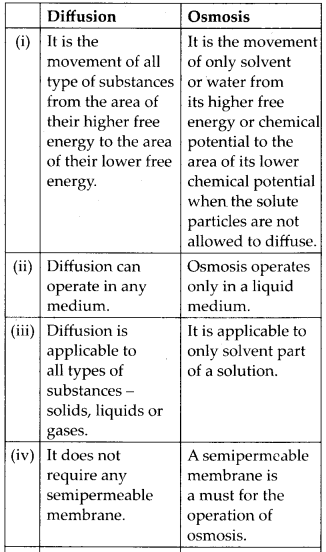
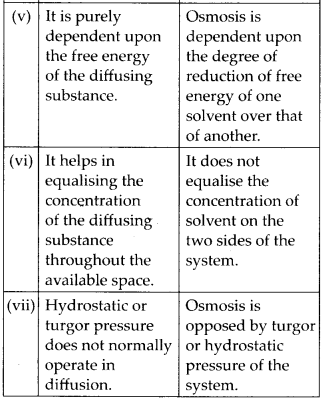
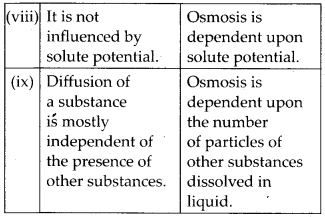
(b) Differences between transpiration and evaporation are as follows:
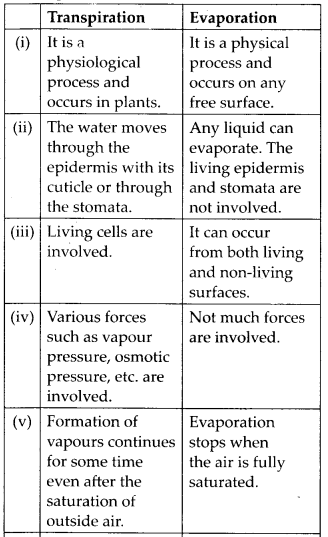
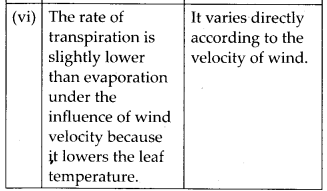
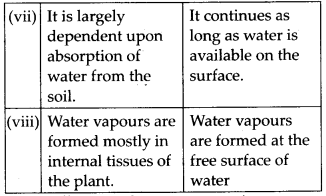
(c)Differences between osmotic pressure and osmotic potential are as follows:
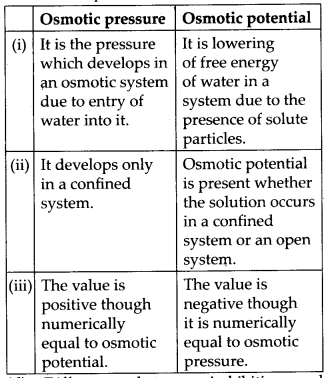
(d) Differences between imbibition and diffusion are as follows:

(e) Differences between apoplast pathway and symplast pathway are as follows:
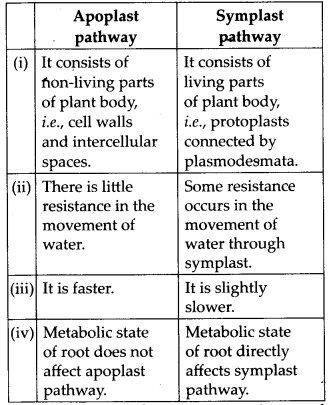
(f) Differences between guttation and transpiration are as follows:
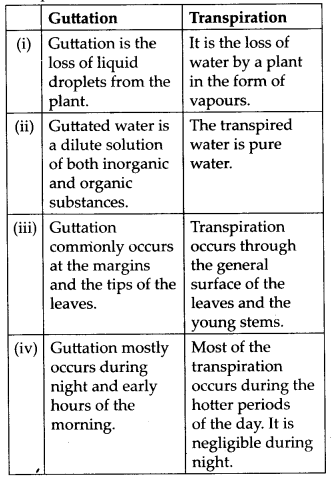


<!–
–>